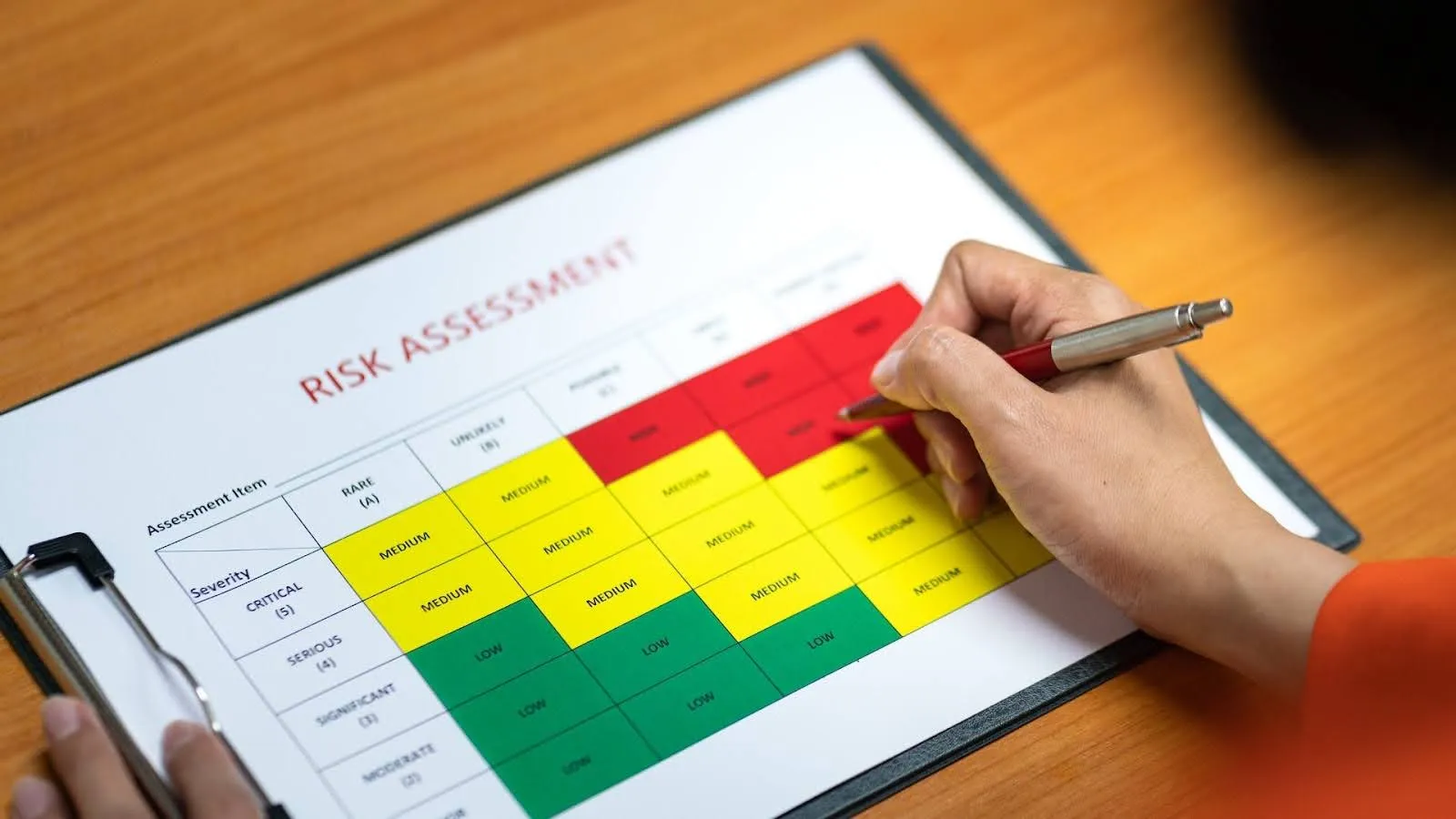Jul 28, 2025
Comprehensive Guide to Transaction Monitoring in AML

By Fraxtional LLC

Are your transaction monitoring systems keeping pace with the evolving landscape of financial crime?
We understand that for many Fintech, crypto startups, and growth-stage businesses, keeping up with evolving AML regulations and implementing effective transaction monitoring systems can feel daunting and, at times, overwhelming.
In the United States, the risk of money laundering and terrorist financing has increased slightly, indicating a growing challenge for financial institutions. Notably, TD Bank faced a USD $3 billion penalty for inadequate monitoring of illicit transactions, highlighting the severe consequences of non-compliance. Similarly, JPMorgan was fined USD $348 million due to deficiencies in its trade reporting systems.
These instances underscore the key importance of advanced transaction monitoring systems in detecting and preventing financial crimes. Financial institutions are under increasing scrutiny to ensure their systems are effective and compliant with regulations. Implementing a comprehensive transaction monitoring system is not just a regulatory requirement but a strategic imperative to safeguard your FinTechs, banks, and small businesses against financial crimes.
This guide will explore the fundamentals of transaction monitoring, its role in anti-money laundering efforts, best practices for implementation, and the latest technological advancements in the field.
TL;DR
- Essential for Compliance: Transaction monitoring is crucial for detecting money laundering and fraud, ensuring regulatory adherence.
- Automation Enhances Efficiency: AI-driven systems provide real-time alerts and scale easily with your business growth.
- Risk-Based Focus: Tailor monitoring to high-risk transactions and continuously update rules to stay ahead of evolving threats.
- Address Challenges: Overcome false positives and resource constraints with accurate data, training, and scalable solutions.
What Is Transaction Monitoring in Anti-Money Laundering?

Transaction monitoring involves a systematic process of reviewing financial transactions for suspicious patterns or behaviors that could indicate money laundering, fraud, or other illegal activities. This process is an integral component of your comprehensive Anti-Money Laundering (AML) program, enabling your FinTech or business to detect and prevent the movement of illicit funds through financial channels.
In AML, transaction monitoring utilizes software and automated systems to analyze transactions in real-time or near real-time, flagging unusual patterns that may require further investigation. These systems work by analyzing transaction data, customer behaviors, and historical patterns to help you identify potential risks.
Now that we’ve defined what transaction monitoring entails, let’s examine why it holds such an essential place in AML regulations and how it benefits businesses.
Why Transaction Monitoring Is Important in AML Regulations?

Transaction monitoring is a fundamental component of Anti-Money Laundering (AML) regulations, as it plays a direct role in identifying and preventing financial crimes, including money laundering and fraud. Regulatory authorities, including the Financial Action Task Force (FATF) and national bodies such as the U.S. Financial Crimes Enforcement Network (FinCEN), require you, as a financial institution, to implement transaction monitoring systems as part of your comprehensive anti-money laundering (AML) compliance frameworks. This is important as money laundering is estimated to account for 2–5% of global GDP, translating to approximately $800 billion to $2 trillion annually. But transaction monitoring systems continuously analyze transaction data, allowing you to detect suspicious activities in real-time.
But how exactly can you integrate transaction monitoring into your compliance framework? Let’s look at a step-by-step guide to ensure you set things up right.
How to Implement Transaction Monitoring in Your Compliance Program?
Integrating transaction monitoring into your existing compliance program requires a strategic, step-by-step approach. By following these key actions, you can ensure your system effectively detects suspicious activities while remaining compliant with AML regulations.
- Assess Your Regulatory Requirements
The first step is to understand the specific AML regulations your FinTech business must comply with based on your location and industry. Different jurisdictions and sectors have varying rules and standards for combating money laundering. By identifying the regulatory requirements that apply to your organization, you can ensure that your transaction monitoring system is aligned with the legal framework, thereby minimizing the risk of non-compliance and associated penalties. - Choose the Right Technology
Selecting the right transaction monitoring software is influential to the success of your program. The software should be tailored to your FinTech business's size, transaction volume, and risk exposure. Consider platforms that offer real-time monitoring, flexible alert systems, and the ability to adapt as your business grows. A system that aligns with your needs will improve detection accuracy, streamline workflows, and reduce the chances of overlooking suspicious activities. - Create Thresholds and Parameters:
Next, you’ll need to set clear thresholds and parameters for your transaction monitoring system. This involves defining the criteria that will trigger an alert when suspicious activity is detected. For example, you may set rules based on transaction size, frequency, or geographical location. Establishing these parameters will help you focus your attention on high-risk transactions while avoiding overwhelming the system with false positives. - Ensure Ongoing Monitoring:
Transaction monitoring is not a one-time task; instead, it's an ongoing process. You must ensure that your system is consistently updated to account for new transaction types and emerging money laundering techniques. As criminals develop more sophisticated methods, your monitoring system must evolve to detect these advanced patterns. Regularly reviewing and refining your monitoring practices will keep your business agile in identifying new risks. - Staff Training
Practical staff training is integral to ensuring your transaction monitoring system operates efficiently. Your employees need to understand the significance of AML compliance and know how to respond to alerts generated by the system appropriately. Providing comprehensive training on the system’s functionality, red flags, and how to escalate issues will empower your team to act quickly and decisively when suspicious activity arises.
By following these steps, you can seamlessly integrate transaction monitoring into your compliance program, ensuring that your business not only meets regulatory requirements but also proactively mitigates potential risks. Staying vigilant and continually optimizing your monitoring practices will strengthen your ability to detect illicit activity and maintain compliance with AML standards.
Once you've established the foundation, it’s time to understand the types of alerts your monitoring system should generate and how they help flag suspicious activities. Let’s take a closer look at what triggers these alerts.
Read: Understanding the Role of a Money Laundering Reporting Officer
Transaction Monitoring Alerts and Suspicious Activity Detection

Transaction monitoring systems are designed to automatically generate alerts when they detect suspicious activity that matches pre-set criteria. These alerts are influential for identifying potential money laundering or fraud and prompt further investigation. Common triggers for these alerts include:
- Unusual Transaction Amounts:
- Large or rapid transfers that notably deviate from a customer’s typical transaction behavior.
- For example, a customer who typically makes small, local transfers suddenly executes a large international wire transfer.
- Sudden fluctuations in transaction amounts or patterns may indicate an attempt to conceal illicit funds.
- Cross-border Transactions:
- Transfers involving high-risk jurisdictions or unusual foreign transactions.
- Funds being sent to or received from countries known for weak regulatory oversight or higher financial crime risks should be flagged.
- The cross-border movement of funds can be a key method used in money laundering schemes, especially when the source or destination country has less stringent anti-money laundering (AML) regulations.
- Layering Techniques:
- The act of breaking up large sums of money into smaller, less conspicuous transactions to obscure their origin.
- For example, large transactions may be split into many small payments to avoid detection.
- Money launderers may use this technique to conceal illicit funds from their source, making it more difficult to trace.
- Shell Companies:
- Transfers associated with businesses that have unclear ownership or minimal operations.
- For instance, money is being transferred between companies that have little to no public information about their ownership or financial activities.
- Shell companies are often used to funnel illicit funds through anonymous entities, making it difficult for authorities to trace the legitimate source of the money.
When an alert is triggered, it does not automatically imply that the transaction is fraudulent. Instead, it suggests that the transaction may require further examination. A manual review of the transaction and the customer's activity is essential for determining whether the alert is valid and whether the transaction involves escalation for further action.
After setting up these alerts, you might wonder how automated transaction monitoring works in the background. Let’s move on to see how automated systems work and how they make the process more efficient.
Automated Transaction Monitoring Systems for AML Compliance

Automated transaction monitoring systems are essential tools in modern Anti-Money Laundering (AML) compliance programs. These systems utilize advanced algorithms, machine learning, and artificial intelligence to analyze vast volumes of transactions in real-time. By automating the detection of suspicious activities, these systems reduce the burden on compliance teams, allowing your business to focus on higher-priority tasks.
The benefits of automated transaction monitoring systems include:
- Real-Time Alerts: Automated systems can instantly flag suspicious transactions, ensuring swift action to prevent illegal activities before they escalate.
- Scalability: As your business grows, automated systems can handle an increasing number of transactions without compromising on accuracy or speed.
- Customizable Rules: Transaction monitoring systems can be tailored to your specific business needs, adjusting thresholds and parameters based on your risk profile and regulatory requirements.
- Cost Efficiency: Automated systems reduce the need for manual oversight, resulting in cost savings while ensuring high compliance standards.
By streamlining the monitoring process, automated transaction monitoring systems significantly enhance the efficiency of AML efforts, making them an indispensable component of any organization's compliance strategy. While automated systems are a game changer, how do they compare to traditional methods of fraud detection? Let’s break down the differences next.
Transaction Monitoring vs. Traditional Fraud Detection Methods
Transaction monitoring and traditional fraud detection methods serve similar purposes, but they differ in their approach and effectiveness in preventing financial crimes. Here’s a comparison table to help you understand their differences:
While both transaction monitoring and traditional fraud detection aim to prevent financial crime, automated transaction monitoring systems offer your businesses superior efficiency, accuracy, and adaptability, making them the preferred choice for businesses seeking advanced anti-money laundering (AML) compliance and fraud prevention solutions.
So, now that we’ve covered the comparison, let’s move on to best practices for implementing transaction monitoring within your organization.
Transaction Monitoring Best Practices for Financial Organizations
Implementing an effective transaction monitoring system requires careful planning, continuous improvement, and adherence to best practices. As a financial organization, focusing on the following key practices will help enhance your transaction monitoring capabilities and ensure compliance with regulatory standards:
- Adopt a Risk-Based Approach: Tailor your monitoring system to address specific risks, focusing on high-risk clients, geographies, and transaction types for efficient resource allocation.
- Regularly Update Monitoring Rules: Continuously review and update monitoring rules to keep up with evolving financial crime techniques and regulatory changes.
- Integrate Technology and Automation: Utilize AI and machine learning to analyze data efficiently, minimize human error, and expand monitoring capabilities as your organization grows.
- Train Compliance Teams: Provide regular training to ensure staff can recognize suspicious activity and respond effectively to alerts.
- Ensure Clear Reporting Procedures: Establish transparent, efficient processes for escalating alerts, investigating suspicious transactions, and meeting regulatory deadlines.
- Monitor Cross-Border Transactions: Implement a system to track international transactions and identify potential risks, such as money laundering.
By following these best practices, you can establish an advanced transaction monitoring program that not only ensures compliance but also helps you manage the risk of fraud and other financial crimes. However, while these strategies can guide you, businesses often face challenges with transaction monitoring. Let’s now explore some of these common obstacles and how to overcome them.
Challenges in Transaction Monitoring for AML

While transaction monitoring is an essential aspect of AML compliance, businesses face several challenges when implementing and maintaining these systems:
- Data Quality and Accuracy: Transaction monitoring systems rely on accurate data to detect suspicious activities. Inaccurate or incomplete data can lead to false positives or missed red flags. Ensuring the quality of high-quality data is key for effective monitoring.
- False Positives: One of the common challenges is dealing with false positives, transactions flagged as suspicious but are, in fact, legitimate. Excessive false positives can strain compliance teams, leading to inefficiencies and delays in investigating legitimate alerts.
- Regulatory Complexity: Different jurisdictions have varying regulations and requirements for transaction monitoring. Companies operating globally must ensure that their systems are capable of adhering to local rules while maintaining consistency across regions.
- Resource Constraints: Transaction monitoring requires notable resources, including software, personnel, and ongoing maintenance. Smaller businesses or startups may struggle to implement advanced monitoring systems due to limited resources.
Now that we’ve discussed the obstacles, it’s time to explore how Fraxtional can help tackle these challenges and optimize your transaction monitoring system.
Enhance Your Transaction Monitoring with Fraxtional’s Expert Compliance Solutions
As financial regulations and fraud risks evolve, businesses need specialized, experienced compliance leadership to stay ahead. Fraxtional provides on-demand, fractional compliance professionals to ensure your transaction monitoring systems are scalable, effective, and compliant.
How Fraxtional Can Help:
- Fractional Compliance Leadership: Rather than hiring a full-time Chief Compliance Officer (CCO) or building an in-house team, we embed experienced compliance leaders directly into your team for strategic oversight and expert guidance.
- Bank Partnerships: We help you establish and maintain strong banking relationships, ensuring your business is bank-ready and capable of managing international transaction risks.
- Policy & Procedure Development: Fraxtional develops customized compliance frameworks to align with your business and regulatory needs, helping you stay audit-ready.
- Money Transmitter Licensing (MTL): We guide you through obtaining and maintaining Money Transmitter Licenses (MTL) across multiple states, ensuring compliance with both federal and state requirements.
- SOC2 Compliance: Fraxtional helps you achieve and maintain SOC2 Type 1 and Type 2 readiness, ensuring secure operations and data protection.
- Independent Audits: We provide independent compliance audits to assess your readiness for regulatory reviews and investor due diligence.
- Risk Assessments: Fraxtional conducts risk assessments to identify and address vulnerabilities in your transaction monitoring systems before they become issues.
Fraxtional delivers scalable, cost-effective compliance solutions for FinTech startups, Crypto platforms, and private equity firms. Our goal is to provide expert leadership that helps you navigate complex regulatory landscapes and safeguard your business from financial crime.
Ready to Strengthen Your Compliance Framework? Contact Fraxtional to learn how our flexible, on-demand compliance solutions can enhance your transaction monitoring and protect your business from fraud.
FAQs
Transaction monitoring is the process of checking financial transactions for any unusual or suspicious activity that might indicate fraud or illegal activities.
In KYC (Know Your Customer), transaction monitoring involves reviewing customer transactions to ensure they match their known behavior and detecting any red flags like unusual spending or transfers.
Transaction monitoring in AML involves using software to analyze transactions in real-time, flagging suspicious activities based on set rules and criteria to prevent money laundering.
TM (Transaction Monitoring) in AML refers to tracking and reviewing financial transactions to detect and prevent illicit activities like money laundering and terrorist financing.
In banking, TM (Transaction Monitoring) is the process of overseeing customer transactions to identify suspicious behavior and ensure compliance with financial regulations.
blogs
Don’t miss these
Let’s Get Started
Ready to Strengthen Your Compliance Program?
Take the next step towards expert compliance solutions. Connect with us today.




